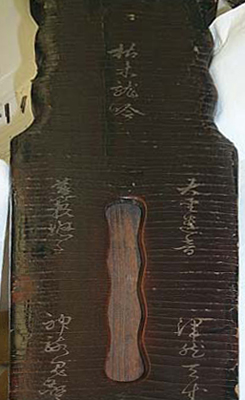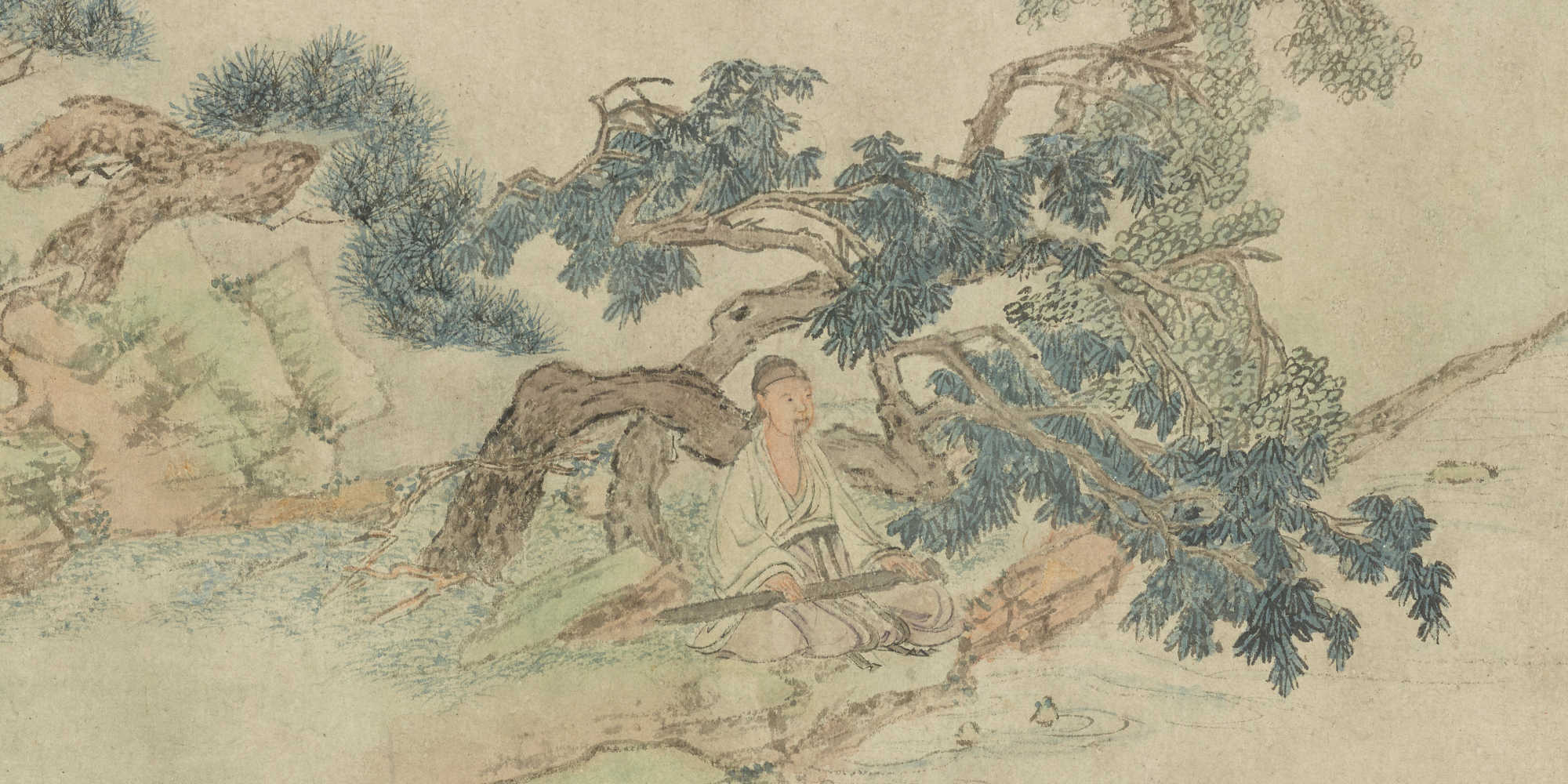|
T of C
Home |
My Work |
Hand- books |
Qin as Object |
Qin in Art |
Poetry / Song |
Hear, Watch |
Play Qin |
Analysis | History |
Ideo- logy |
Miscel- lanea |
More Info |
Personal | email me search me |
| Origins / Collections / National Museum of Asian Art website | 首頁 |
|
National Museum of Asian Art
1
Freer and Sackler Galleries, a part of the Smithsonian |
弗利爾美術館
1
From the back of Kumu Longyin 2 |

The NMAA, which combines the Freer and Sackler Galleries, has seven qin zithers, five made from lacquered wood plus one each of bronze and iron. In 2020 the museum published a lavishly illustrated book with text by Yang Yuanzheng describing these instruments in detail,3 and as of 2025 they could all be seen online.4 They are, in their order as discussed by Yang,
- No name Ming dynasty bronze qin ("zither"). (1915; Yang: pp.19-24 and 87-104.)
Originally dated from Zhou, perhaps influenced by the tradition of images such as these. - Dragon's Moan Northern Song dynasty ("zither): 枯木龍吟 Kumu Longyin. See at right and
below.
(1915/1920; Yang: Withered Wood, Dragon's Roar; "not Tang", pp.59-85.) - Frosty Sky, Iron Horse Ming dynasty iron qin ("musical instrument [qin]"); 霜霄鐵馬 Shuang Xiao Tie Ma;
"Iron Horse" means "Iron Shod Horse". (1919; Yang: pp.107-116; another reference) - Spring Breeze Ming dynasty ("Seven-stringed zither"); 春風 Chun Feng. (1999; Yang: pp.116-123)
Probably late Ming; known to and commented on by several post-1949 qin masters. - Singing Phoenix Ming dynasty ("zither"); 喈鳳 Jie Feng; unnamed in website. (1915; Yang: pp.124-133)
Came to Freer with Dragon's Roar; 1638; mass market qin from a Suzhou studio. - No name Ming dynasty ("zither"). 2001; Yang: 133-141; accession date unclear.
On loan to Sackler
from the U.S. Fish and Wildlife Service; made in same studio as Singing Phoenix. - White Clouds Infuse the Melody Early Republican (not "Song Dynasty"); qin, but not "seven-stringed lute (qin)"!
白雲入韻 Bai Yun Ru Yun; long inscription on back). (1987; Sackler; Yang: pp.141-149)
 The order above is roughly chronological except for the bronze qin. Yang Yuanzheng mentions it first because he uses it to represent the traditional beliefs about the origin of the qin, as seen in the lists and images such as are on
this page having "歷代琴圖 diagrams of historical qin" dating back to the legendary emperor Fuxi, and in images such as here at left from 1539 (begin II/20b). It was originally thought these were based on historical instruments, and if the Freer instrument truly dated from the Zhou it would be by far the earliest known qin in the classical style. However, the archaelogical findings from the Zhou dynasty tombs suggest quite a different story. Some details of this issue are discussed here under Origins.
The order above is roughly chronological except for the bronze qin. Yang Yuanzheng mentions it first because he uses it to represent the traditional beliefs about the origin of the qin, as seen in the lists and images such as are on
this page having "歷代琴圖 diagrams of historical qin" dating back to the legendary emperor Fuxi, and in images such as here at left from 1539 (begin II/20b). It was originally thought these were based on historical instruments, and if the Freer instrument truly dated from the Zhou it would be by far the earliest known qin in the classical style. However, the archaelogical findings from the Zhou dynasty tombs suggest quite a different story. Some details of this issue are discussed here under Origins.
From 6 February to 1 October 2000 three qins from the Smithsonian collection were displayed in an exhibition called The Dragon's Moan, named after the qin of that name in their collection. (A literal translation of the full title of this qin is "Dragon Intoning from within Withered Wood", but the character "吟 yin" has long been interpreted in a great variety of ways.) And from 30 April to 17 September the Sackler Gallery exhibition Music in the Age of Confucius also exhibited what are now generally considered as predecessors of the classical qin . However, these qin (or perhaps better qin-types) were not from their permanent collection.5
When I first visited the museum storage area, in 1997, I saw two of their lacquered wooden qins and the iron and bronze qins. The lacquered ones were Dragon's Moan and Jie Feng (Singing Phoenix: "jie" suggests a bird song), which did not go on display in the exhibition, instead being replaced by a newly acquired Ming dynasty qin called Spring Breeze, said to be in playing condition. During my visit the only one said to be in playing condition was the iron qin; of course it had a very weak tone.
What prompted me to visit the museum at that time was that I had just produced my first CD using a borrowed Song dynasty qin, and was hoping a museum might let me use one of their antique qins to do my Shen Qi Mi Pu recordings.
I was particularly interested in Dragon's Moan (or Dragon's Roar), whose full title, Kumu Longyin, has the literal meaning "the Dragon intones from the dried wood". Several players in China (including Wang Shixiang, see below) had recommended it to me. Apparently several famous Chinese players and scholars who examined this qin in the 1940s spoke so highly of it that it now has a reputation as the best instrument in an American museum.
During my visit I saw in museum records that Zha Fuxi re-strung it in 1945 and Wang Shixiang himself re-strung it in 1948. They said it dates from either Tang or Song dynasty.
Unfortunately, in 1997 I found that the lacquer near the lower studs was so uneven that the instrument was no longer playable. At that time I was told the Museum had a policy of not repairing such instruments.
In 2002 I revisited the collection together with other members of the New York Qin Society, at which time I was told that either I was misinformed or the policy had changed, and that this one may soon be restored. The museum had also recently acquired another Ming dynasty instrument.
Footnotes (Shorthand references are explained on a
separate page)
1.
National Museum of Asian Art: Freer and Sackler Galleries (弗利爾美術館)
The Smithsonian’s National Museum of Asian Art was formed in 2019 by uniting under one roof the Freer Gallery of Asian Art dating from 2023 and the Arthur M. Sackler Gallery, which opened in 1987. The Freer can exhibit only items in its original collection; the Sackler can exhibit loaned objects.
The Chinese title of the National Museum of Asian Arts should be 國家亞洲藝術博物館 Guojia Yazhou Yishu Bowuguan. Before that the Chinese title would have been 弗利爾及賽克勒美術館 Fulier ji Saikele Meishuguan, but Chinese writings usually refer to it only by the Chinese version of the original title, 弗利爾美術館 Fulier Meishuguan.
(Return)
2.
Inscription on the back of the Freer/Sackler's qin called Dragon's Moan (枯木龍吟 Kumu Longyin)
Image edited from a photo by Stephen Bourne, one of
a set taken during the 2002 visit by the New York Qin Society. There had been claims that the qin itself had an extra board added inside called a "雙層面板 double layer soundboard" (thinner than this?), intended to enhance the sound by adding an extra sound cavity for much of the length of the sound box, but Yang Yuanzheng's research suggests that in this case the piece inserted served as a nayin.
(Return)
3.
Museum publication: Yang Yuanzheng, Dragon's Roar, Chinese Literati Musical instruments in the Freer and Sackler Collections
© 2020 Freer Gallery of Art and Arthur M. Sackler Gallery Washington D.C.; Hirmer Publishers, Munich; and Yang Yuanzheng.
The book has six chapters:
- Acquisition: Purchases by a gentleman
How five qin were acquired by Charles Freer - Archaeology: Truths gradually revealed
A study of the qin-types from Chu, in particular those in the tomb of Liu He (92-59), a Han prince who apparently had some of those instruments in his native Shandong province. - Withered Wood, Dragon's Roar
The most famous instrument in the collection - The Bronze qin: Recasting a lost Atlantis
An instrument once thought to date from the Zhou dynasty - An Iron Horse and Worked Wood
The other five qin in the National Museum of Asian Art - No longer an end without a journey
Summation of the argument that the predecessor of the classical qin was exactly the instruments found in the Chu tombs; pictures of the earliest surviving classical qin (in Japan).
- List of qin types: 128 named types showing where the images are in 21 handbooks between 1403 and 1886 CE
- Transverse scans of four medieval qin (756, 756, 968, 1009 [Dragon's Roar] CE)
- Transverse scans of four early modern and modern qin (in the NMAA: one 15th c [?], two early 17th c., one modern)
- Chinese documents related to Freer's acquisition of qins
- Then:
- Chronology (of Chinese dynasties)
- List of tables and figures
- Glossary of Chinese characters
- Works Cited
- Index
- Publication details; plus right column gives source of five color plates of paintings
- see especially the left handed qin player in the section at right of the painting "after Qiu Ying, Playing the zither beneath a pine tree".
| pp. 192-193: Left handed player (on museum site) |

(Return)
4.
Zither (qin)
Note that as of 2022 the "type" of five of these instruments was classificed as "zither qin", one is called only a "zither", another a "seven-stringed lute (qin)". Thus searching the site only for "qin" or for "zither" will not find all of them.
Since this page was made the URLS have changed at least twice, but with the above information they were still pretty easy to find. At present, six of the URLS list accession numbers coded by have dates, but the last one listed above seems to use a different system, without a clear date. Perhaps this is connected to this statement with it, "Transfer from The United States Fish and Wildlife Service, Division of Law Enforcement".
(Return)
5.
"Qin-type" instruments in the exhibtion "Music in the Age of Confucius"
These predecessors of the classical qin are discussed in detail by Prof. Bo Lawergren in Chapter Three, "Strings", pp.65-85 of the museum catalogue Music in the Age of Confucius, Smithsonian Institution, 2000.
(Return)
Return to museums and libraries or the Guqin ToC